I’m giving a presentation today at the ITSMA‘s annual marketing conferencing on the topics of agile marketing and the rise of marketing technologists — two of my favorite subjects. I’ll be discussing them in the context of the 5 meta-trends in modern marketing that I wrote about earlier this year.
Here’s the presentation, along with an essay version of my talk. It’s long — about 8,000 words — so if you want the Cliff Notes version, skip over to my original marketing meta-trends post. But if you give me the next hour, I’ll share with you the best of what I know about the state of modern marketing:
Marketers today have been struck by the famous Chinese blessing: may ye live in interesting times. Or is that a curse? A little of both.
We do know that marketing is moving faster than ever. David Meerman Scott’s latest bestseller, Real-Time Marketing, pretty much sums it up in the title. Marketing may not literally be real-time today, but it sure feels like it’s headed that way.
Marketing is also getting more complex. In a survey of CMOs last year by IBM, 79% of them said they expect high to very high complexity in marketing over the next 5 years. Yet only 48% of them feel prepared for that complexity. This leaves 31% of them in a “complexity gap.” (Sounds like something out of Dr. Strangelove.)
And I suspect that out of the 48% who say they are prepared, at least half of them are blissfully delusional. Because marketing is getting really complex. Just take a look at this overview of marketing technologies out there — we’ll cover this in more detail a little later — and you can feel the complexity emanating from this graphic.
And, just to make things more interesting, all this is constantly in flux. We’re in almost a perpetual state of disruptive innovation in marketing today, where the only constant is change.
But there is some good news in this maelstrom. The same forces driving these challenges in marketing are also making marketing more strategic. Marketing, which at times has been on the periphery of organizations, is being gravitationally pulled to the very core of today’s business. In a recent Gartner survey of marketing managers, only 9% thought marketing was strategic 2 years ago; 26% describe it as strategic today, and 67% believe it will be strategic two years from now. That’s a 7X increase!
Okay, as marketers, we’ve been known to be aspirational. But objectively, there is a powerful transformation underway here. But to harness that opportunity, we have to master the challenges of speed and complexity.
To quote the Talking Heads, “You may ask yourself, how do I work this?”
My goal today is to give you two significant ideas for how to conquer those speed and complexity challenges. As you may have inferred from the title of this talk, those ideas are agile marketing and the embrace of marketing technologists. But I think it’s best to frame those ideas in the context of 5 meta-trends in marketing.
What’s a meta-trend? Well, there are a huge number of “trends” in marketing — a new one every week it seems. A meta-trend is something deeper, like tidal forces moving waves to shore.
Those five meta-trends are:
- The ongoing migration from traditional to digital; not just in marketing, but in business and life.
- The integration of previously independent media silos into converged media.
- The blurring of marketing communications into customer experience delivery.
- The splicing of technology — code and data — deep into marketing’s DNA.
- The shift from rigid planning to agile iterations in marketing management and culture.
These last two are where we’ll focus on the rise of the marketing technologist and agile marketing.
Meta-Trend #1: The Great Migration to Digital
But let’s start with the mother of all meta-trends, the migration from traditional to digital — again, not just in marketing, but in business and life overall. I know, you’ve been hearing about this meta-trend for 15 years. But to quote Amara’s Law, “We tend to overestimate the effect of a technology in the short run and underestimate the effect in the long run.” Many of the predictions of how transformative digital would be are only now manifesting themselves in our day-to-day lives.
Mary Meeker, a partner at Kleiner Perkins, is renown for her yearly presentations of Internet trends. She’s like The Oracle in The Matrix. Her presentation this year included a section titled The Re-Imagination of Nearly Everything. It’s a collection of about 50 vignettes of how digital innovation has changed — and is changing — nearly everything today.
Here are just a handful to share with you:
- The Re-Imagination of Computing Devices — from desktops and laptops to tablets and smartphones.
- The Re-Imagination of Connectivity — from limited, fixed points of access to ubiquitous connectivity.
- The Re-Imagination of Yellow Pages — a massive business, swept away by disruptive innovation.
- The Re-Imagination of Video — the death of Blockbuster, the rise of Netflix and YouTube Nation.
- The Re-Imagination of News — not just disrupted business models, huge changes in social culture.
- The Re-Imagination of Business Collaboration — new tools for asynchronous and distributed work.
- The Re-Imagination of Recruiting — from paper resumes and career fairs to LinkedIn networking.
And this is just a tiny sample. Meeker’s presentation includes dozens of other great examples. But more importantly, she concludes by saying, “You ain’t seen nothin’ yet.” The magnitude of upcoming change, as a function of our digital world, will be stunning.
To appreciate where we are today in the digital revolution, recent research from Google shows that, here in the U.S., 90% of all media interactions are now screen based. And it’s not just one screen. We’re officially in the Four Screen Era: TV, laptop, smartphone, and tablet.
And I love this infographic from Intel that illustrates What Happens in an Internet Minute. 1.3 million video views on YouTube. 2 million search queries on Google. 100,000 new tweets on Twitter. 47,000 mobile apps downloaded. 204 million emails sent. At least half to my inbox. Over 639,000 gigabytes of data transferred. These stats are already out of date, and future growth will be staggering.
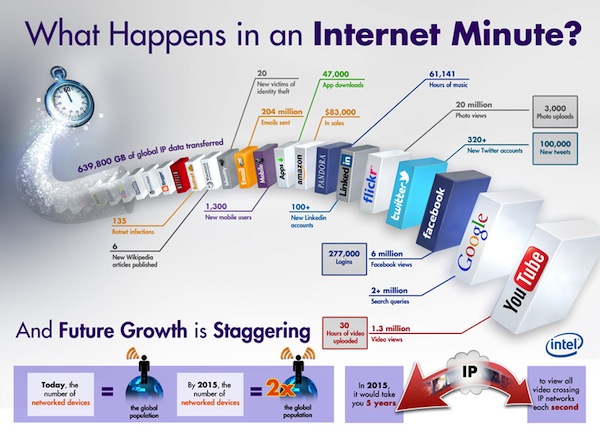
Bottom line is that digital is the backbone of our lives today. And if there’s a fundamental axiom in marketing, it’s this: where the audience goes, marketing will follow.
In a nod to physicists and the 1st law of thermodynamics, there’s a parallel 1st law of marketing dynamics: conservation of resources. Marketing has finite budget, time, attention. If it allocates resources towards something new, like digital, then it’s not investing those resources elsewhere. I know, kind of obvious. But looking at marketing investment as a pie, this can be quite telling.
So the latest global ad spend information from Zenith/Optimedia shows the slice of pie from the $500 billion global ad economy going to digital continues to grow in size. Digital was 14.7% of the global ad spend in 2010. This year it will be almost 18%. In two more years, it will be 21.5%.
But marketing is more than advertising, of course. So how much of marketing is digital?
Well, it depends on who you ask. I recently looked at three different research reports with three different answers. Econsultancy released a survey where nearly 1/3 of the respondents planned to allocate 50% or more of their budget to digital. Now, Econsultancy serves a digitally savvy constituency, so it’s quite possible that their sample was biased in this regard. But still, the fact remains that you have a non-trivial set of companies out there who are now driving their marketing primarily through digital. Maybe some of them are small start-ups competing in your space?
Another recent report came from IDC, their 2012 Tech Marketing Benchmarks Study. On average, the companies they surveyed are now allocating nearly 30% of their budget to digital marketing. Now these are folks who are marketing technology, so it makes sense that they’d be biased towards tech-centric digital channels. But now we’re talking about enterprise-class companies. These budgets are not just digital advertising. They’re email, web sites, marketing automation, digital events, social media.
And then the third report is the ITSMA’s research — based on your survey input — in which digital accounted for 16% of the marketing mix in 2012. Again, not just digital advertising, but social media, websites, email, mobile marketing, webinars, etc.
Now we could debate who’s at 16% vs. 30% vs. 50% allocation towards digital marketing, why that is, whether it’s overstated or understated. There’s definitely a lot of noise in these numbers. But if we step back to see the forest for the trees, one conclusion is unmistakeable: digital is growing.
Recent Gartner research with 261 IT managers and 251 marketing managers in the U.S. and Europe polled them about where investment was increasing or decreasing across a number of digital categories. Social media: 72% increasing. Mobile applications: 73% increasing. CRM — which powers digital marketing behind the scenes: 61% increasing. And so on.
Individually, these digital-centric initiatives are where the activity is in new marketing investment. And collectively, they add up.
But why are we making these investments in digital? Part of it is the argument for lower cost of customer acquisition or cost-per-lead. But cost is only the third of the top 3 drivers of the shift towards digital. The top two reasons really are:
- Increased measurability and accountability
- Increased customer engagement
Measurability is big because it tells us what’s working. But it’s that second one which I believe is key to the story: we’re going digital because that’s where we need to be to engage with our customers. As a bonus, we’re also able to glean much better insights from our customers in the digital domain.
Where the audience goes, marketing will follow. And the audience is more digital every year.
Meta-Trend #2: From Media Silos to Converged Media
All right, the next meta-trend is the shift from media silos to converged media. The three silos have been: paid media, such as advertising; earned media, such as PR and social media goodness; and owned media, such as websites and mobile apps.
The best way to understand how and why all these things are converging is something Google calls the ZMOT: the Zero Moment of Truth.
Not long ago, marketing — at least consumer marketing — could be described as follows. We’d hit our target audience with a stimulus, advertising of one kind or another. We’d hammer them with it repeatedly. It was all about frequency and recency. Some time would go by, and eventually, that prospect might find themselves in a store, considering a purchase in our category. They’d look at the shelf with all the different brands and make a decision for which one to buy. The CEO of Procter & Gamble, A.G. Lafley, called this the First Moment of Truth. Your brand marketing is working if the consumer chooses your product.
The Second Moment of Truth was when they got the product home, tried it for the first time, and decided whether or not they liked it.
Google makes the case that there is a new moment of truth that comes before both of these today. Now, when a prospect receives a stimulus, they can immediately pursue it online. They don’t have to wait until their next trip to the store, or even necessarily wait until they’re ready to consider buying. When a stimulus flashes through their heads — whether inspired by something the marketer directly produced or something that another influencer shared with them — they can immediately jump on the web and check it out.
The ZMOT is a flurry of activity. These prospects can query search engines, visit your web site, read educational content, follow you on Twitter, visit the web sites of your competitors, read reviews by journalists, bloggers, or other customers, discuss it with friends, check out your online communities, comparison shop, and so on.
What’s fascinating about the ZMOT is that a lot of this content is outside the direct control of the marketer. In fact, a large portion of it comes from your other customers. Actually, if that prospect converts and becomes a customer of yours, they may very well contribute into the ZMOT experience of future prospects as well.
And buyers are becoming very adept at picking up on inconsistencies between brand-driven marketing messages and the dialogue around those brands shared by other customers and external influencers. We all live this every day, but it’s pretty amazing when you step back to think about how different the buyer experience has become in our digital world.
I know, this model I’ve just described has its origins in consumer marketing. But before you dismiss it as not being relevant to B2B marketing, consider this quote from Jonathan Becher, the CMO of SAP who said, “Big, large, glass buildings do not buy software. People do.” B2C behaviors are appearing in B2B buying because the ZMOT has become an incredible source of information and power for business buyers.
It’s the shift in information asymmetry that is really at the heart of the ZMOT revolution. In many industries, sellers used to have a lot more information than buyers. Salespeople cleverly used this to their advantage, as buyers had to rely on conversations with these sales experts to answer many of their questions.
But today, there’s much more information online than what most salespeople have to offer, and the balance of power has swung in the other direction. Buyers don’t need salespeople to answer a lot of their questions, and this has dramatically reduced the leverage that most sales teams have and used to take for granted.
At the same time, it’s significantly increased the responsibility for marketing to get the right information out into the digital ether, so that when buyers are doing their ZMOT exploration, they find great content from you — and social proof from others — that will convince them that you’re the right seller for what they want. To achieve this, marketers must do great content marketing. They must engage authentically in social media marketing. Most of all, they need to take more responsibility for the overall customer experience, because that’s going to drive a lot of what other people say about you.
Simple, right?
But here’s the really tricky part. The way in which we used to perceive the buyer funnel, where prospects would enter our universe at a specific touchpoint and proceed linearly through distinct stages of marketing is complete fantasy. Maybe it always was fantasy to some degree, but the ZMOT has thoroughly obliterated it.
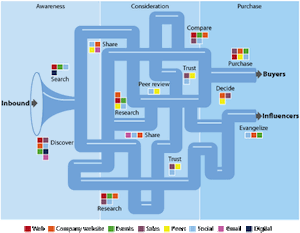
Today’s buyer funnel actually looks more like this: prospects zig-zagging back and forth across a wide range of digital touchpoints, pulling in research from web searches, your web site, email subscriptions, social media interactions, feedback from peers, and interactions with salespeople — although those salespeople often have limited visibility into the rest of the buyer’s activity in the funnel. Touchpoints with real people are much more controlled by the buyer than the seller.
And just to make it a little more interesting, prospects also switch among devices while they’re zig-zagging through this “funnel.” It’s called multi-screening. Start a search with a smartphone, pick up on it at work on a laptop, follow up on a tablet at home later that night. But — here’s the catch — they still expect a consistent representation from you.
In short, this is why marketing media has now converged. You can’t address a buyer with a single isolated marketing vehicle. It’s too easy for them — and it’s in their interest — to plug into the ZMOT and examine you through a variety of other lenses. If there’s a disconnect between any of them — your web site says something different than your Facebook page which says something different than an email they just received from you which says something different than what the salesperson they talked to last week said — you’re going to raise questions and shake their faith in you. In some cases, that slows buyers down; in other cases, it will outright turn them away.
This is why marketing needs to be managed as converged media. There’s a great report by the analyst firm Altimeter that describes the architecture of converged media marketing. I’d definitely recommend downloading it — it’s free.
The point I want to make about converged media, however, is that it’s mandating changes to the process of marketing management. It’s faster, and it’s increasingly mediated by technology.
As we move from media silos to converged media, we need to manage truly integrated marketing at a whole new scale.
Meta-Trend #3: From Communications to Experiences
Media is a funny term. The common notion of it is as a channel for communications. Most of what is popularly thought of as “marketing” is communications. Telling stories with language and images. Getting the right message to the right audience at the right time. The third meta-trend is that marketing is evolving from delivering such communications to delivering actual customer experiences.
Of course, marketing has always been in the business of delivering experiences. At least in the textbooks. Out of the famous four P’s, the first one is “product.” In the broadest sense, customer experience is the ultimate incarnation of product.
This quote from the CEO of Mercedes-Benz USA — “every single customer experience is a brand moment of truth” — could have been said 20 years ago. It was actually made earlier this year and highlighted as a major insight in a report on the future of marketing. But why should customer experience be seen as something new in marketing?
First, we have to confront the harsh reality that while the textbooks talk about the 4 P’s, most marketing in most companies has been primarily focused on promotion. That’s certainly where the bulk of money in marketing has been allocated. It’s how marketing has been typically viewed by other executives. It’s why marketing has been considered less strategic in previous years.
For a long time, communications has overshadowed customer experience in marketing.
But there are two reasons that this is changing rapidly.
The first is that the distance between marketing communications stimuli — such as advertising — and actual customer experience has collapsed to near zero. This is the “zero” in the Zero Moment of Truth. It’s the distance it takes someone to click.
Respondents click on your ads or emails, and they start actually interacting with you. Does your web application or mobile application give them what they need? Is it a great experience? This isn’t just about how your site looks or what it says. It’s how it actually works. Think about the personalized recommendations on Amazon — that’s brilliant marketing, but it’s not communications so much as it is functionality. What capabilities do you extend to your customer online? Digital marketing is quickly turning into digital business.
Even if your final product or service isn’t digital, the experience surrounding it is ultimately part of your offer. How easy is it for them to do business with you across the entire customer lifecycle, from that very first touchpoint in the ZMOT?
You can’t separate communications from experiences in the fluidity of the digital world.
The second reason why customer experiences are now so crucial to marketing is the ubiquity of social media. Marketing no longer fully controls the narrative around its brand — at least not directly. In the ZMOT, prospects have unfettered access to what other customers and influencers have to say about you. They’re just one Google search away from praise, criticism, kudos, and complaints about your products and services, your policies and principles.
I’ll grant you that such conversations are more visible around consumer brands, but even in B2B, you’re seeing commentary on blogs, customer opinions on Q&A sites such as Quora, remarks made on Twitter associated with your brand name, discussions within your own online communities, and so on. More than ever, your brand is what other people say about you.
Marketing needs to care passionately about customer experience throughout the entire lifecycle of customer relationships because the only way to have a great brand in the age of social media is to have your customers corroborate your brand story. “Yes, they’re awesome. Here’s what they did for me…”
Getting the product right is a promotional strategy in the ZMOT.
Let me emphasize again that I mean “product” in the broadest possible sense. Your product may be a service. But even more than that, your product really is the entire lifecycle of a relationship that a customer has with you — from the very first touchpoint onward. And from their initial discovery and research, through purchase, post-purchase support, repeat purchases, and beyond, at all these touchpoints, they’ll have the ability to consult and contribute to the ZMOT.
This is why Forrester has declared that we’ve entered the Age of the Customer.
Let’s sum it up this way: great experiences = great brands. That is the meta-trend of marketing communications evolving into marketing experiences.
Meta-Trend #4: The Technologification of Marketing
Marketing is becoming a technology-driven discipline, where code and data are as fundamental to marketing’s DNA as art and copy have been.
I was at a conference last year where a CMO burst out, “I feel more like a CIO and than a CMO! I have marketing automation, CRM, listening platforms — I’m up to my eyeballs in technology.”
Many of you may feel his pain because marketing has become swamped with technologies. Every year, I put together a rough marketing technology landscape graphic to illustrate the different kinds of technology at play in marketing and who provides them. This is the most recent version I put together in September.
There’s 350 different vendors in this graphic, and I’ll be the first to admit that it’s woefully incomplete. I get lots of emails from people telling me about all the great companies that I missed. But as a representative sample, it makes its point: there is a veritable flood of marketing technology out there.
Let’s just take a quick walk-through of this graph. You have web site technologies, anchored by web servers and web content management systems. You have optimization software that layers on top of your web site to do A/B testing and multivariate testing. There are solutions out there specifically for landing pages and campaign-specific web experiences — my company, ion interactive, is one of the leaders in that space.
There’s software for organic search engine optimization, keyword optimization, content analytics. There’s software for managing pay-per-click advertising on search engines and social media sites like Facebook and LinkedIn, with advanced capabilities for bid optimization. You have a huge ecosystem for displaying advertising, with ad networks and exchanges, demand-side platforms. There are companies specializing in audience targeting and personalized advertising. Software for testing and optimizing different creatives. Software for video advertising. Multi-channel and integrated marketing platforms coordinating these pieces.
Speaking of coordination, there’s a whole category of marketing automation technologies that approached integrated marketing from a native digital background. These connect back into CRM systems, which now also leverage external data providers to augment customer profiles. There’s a fantastic set of email marketing platforms and service providers out there, helping us get those 204 million emails per minute out the door.
Then, of course, there’s the field of social media marketing software, with technologies for monitoring, promotion, and management. There’s marketing analytics software of every kind you can image: web analytics, customer analytics, audience analytics, attribution systems, dashboards, and so on. There’s the big sister of analytics, business intelligence software platforms, and the big brother — no pun intended — of big data. Marketing also manages a plethora of databases, internally and in the cloud.
Whew. I’m tired just reading out half the categories.
At this point, you might be saying to yourself: OMG, can’t IBM or Oracle or someone like that come in and consolidate all of this into one integrated solution and wrap a bow on it? Well, they’re certainly trying — as some of you in the audience will attest.
But even while there are strong market forces for consolidation of marketing technology, there are also strong forces promoting ongoing diversification. In fact, there are three.
The first is that new technology is constantly emerging. The digital world is still being actively shaped by new start-ups. Who will be the next Facebook or Twitter, and how will that change the opportunities for how marketers engage with their audience? New technology platforms such as Google Glass will appear — things that sound like science-fiction at first, but are quickly becoming real. As long as there is disruptive innovation out in the world, its ripples will open up new opportunities for marketing to leverage and coordinate around it.
The second force driving diversification is that brands themselves are constantly seeking ways to stand out from their competition. As a marketer, you don’t necessarily want to be interacting with your customers the exact same way your competitors do. You want to find a way that’s better — or really, a way that’s more unique to you brand. And you’ll seek software that best helps you achieve that differentiated approach.
And the third force driving diversification is that software, frankly, is much easier to create and scale than at any other point in history. By an order of magnitude. Thanks to cloud platforms such as Amazon and Rackspace, open source software projects for everything from databases to artificial intelligence, great application frameworks such Ruby on Rails, etc., a couple of start-up founders in a garage can build something in months that would have taken huge teams, millions of dollars, and years of calendar time not too long ago.
Software start-ups have a perfect storm of incentives to enter the marketing space. It’s a huge market of billions of dollars, money that’s actively moving from old solutions to new ones. Cloud computing makes software not just easier to build; it’s easier for customers to adopt as software-as-a-service. The measurable nature of digital makes the ROI case for new software innovations easier to justify. And the economics of software as business are good and getting better.
So will marketing technology consolidate? I doubt it will compress down to a handful of companies. However, I do think that we may see a small number of open marketing technology platforms that become the core around which a wide variety of point solutions plug into a centralized and coordinated system of record.
But let’s not get too deep into prognostication of the future. What we can say today is that we’ve officially entered The Golden Age of Marketing Software. As marketers, we have a bountiful feast of technologies that are now laid at our feet, with all these competitors vying to give us the best possible capabilities. But it’s more than that.
The reason we’re in the Golden Age of Marketing Software is because software is increasingly how we see and touch the world. In the digital world, software is marketing’s eyes, ears, and hands.
Think about it. Your choice of analytics software, how you configure, the reporting views it presents you, will shape your perceptions of what your prospects and customers are doing online. Your choice of automation software, the capabilities and user interface it present you, will guide how you design marketing processes. Your choice of optimization software will influence which tactics you focus on and how you hone them. Your choice of listening software will direct how you engage in social media. Targeting software will, based on its architecture, change how you define audience segments. CRM systems — by the very definition of their name — will impact how you structure customer relationships in your organization.
I confess, I’m a fan of 80’s science fiction movies. So there was this epic sci-fi movie called Dune, where everything revolves around the production of spice on a distant planet. They say, “He who controls the spice, controls the universe.”
Well, with the way marketing increasingly relies on software as its interface to the world, we could say, “He who controls the software, controls the marketing.” He or she.
So who does control marketing technology in your organization? With all the different moving elements that need to be synchronized for that covered media vision, who choreographs your marketing technology ballet? Or is it more of a mosh pit?
Who should make technology decisions in marketing? Marketers? The IT department? Vendors or agencies? And on what basis should they make those decisions? Technical depth? Business alignment? Marketing vision?
In theory, this would be accomplished by a superset of the IT department and the marketing department. But in many organizations, IT and marketing — how to phrase it diplomatically? — have encountered non-trivial challenges in their collaboration. There’s often tension between these two groups. But why, exactly?
Forrester did a survey a little while ago where they asked a bunch of marketing managers what their perceptions of the IT department were. It’s a little like Family Feud. The #1 answer, survey says: IT is the department of “no.” IT doesn’t speak marketing’s language. IT doesn’t understand the need for speed. IT isn’t concerned with the customer.
Ouch. But before you feel too badly for the IT department for this public beating, you should know that Forrester also asked IT managers what their perceptions of marketing were. The #1 answer, survey says: marketing is spin. Marketers don’t care about integration.
But let’s rise above the petty jabs and go directly to the CIO and the CMO. Surely, these two executives are focused on the same ultimate mission of growing the business, right? Well, they are. But the priorities IT and marketing have for growing the business diverge pretty dramatically. When Forrester asked CIOs and CMOs what their top priorities were, two of the ones that the CIO emphasized were:
- Maintain control of technology costs
- Minimize and control risk
Meanwhile, the CMO doesn’t have either of those on their list. But they do have two that the CIO doesn’t have:
- Define the future of customer relationships
- Create the new brand experience
Now, it’s not that CMOs aren’t concerned about cost and risk. They are. But they’re weighed in the context of keeping pace with a fast moving, innovative market.
Facebook has this edict painted on the walls in their office: MOVE FAST AND BREAK THINGS. Mark Zuckerberg told his engineers, “Unless you are breaking stuff, you are not moving fast enough.” Now, not every company is — or should be — Facebook. But you have to see his point. In a competitive market, where the world is being transformed around you, you’re either quick or you’re dead.
Given what we know about marketing, the meta trends of digital transformation, converging media, experience creation, and how fast that’s all moving, you might be able to imagine something like this being painted on the wall of the marketing department. Maybe? Possibly?
But it’s really hard to imagine it on the walls of the IT department. That doesn’t play to IT’s strengths and the core of its value proposition in most organizations.
But marketing technology is different than most IT-managed technologies. Given all the changes and innovation underway, it’s in marketing’s interest to continually experiment and push the envelope on new technologies. Yes, there’s value in standardizing system too — once the fit and maturity is right — but then there’s always another experiment out on the horizon.
So how do we solve this problem of marketing technology management?
Well, there’s always the efficient solution of a committee. Ha, ha, I’m kidding. Well, half-kidding. I’ve studied 14 different organizational models for how marketing and IT can collaborate. Lots of models can work, but some work better than others.
The organizational structures that don’t work as well, in my opinion, are those where marketing and technology responsibility is split in half, King Solomon style. This group does the marketing half, this other group does the technology half. Because, as we’ve already discussed with the focus on customer experiences in the digital world, the marketing and the technology are all tangled up together. You can’t break marketing technology in two without creating a dangerous gap.
The best organizational structure, I think — and Forrester has recommended this too — is for there to be a technology group based in the marketing department. Forrester calls it a marketing technology office. I call it the role of a chief marketing technologist. This marketing technology team reports directly to the CMO — these are technically skilled professionals, but their mission, their passion, is marketing.
They do have dotted lined responsibility to the CIO, because it is important that their efforts are coordinated. But here IT is playing more of a governance and advisory role rather than a hands-on management role.
The chief marketing technologist, with his or her team, takes full responsibility for marketing’s technology stack. They drive the selection and operation of these tools. They collaborate with their peers in the rest of the marketing department to fully harness the creative potential of these tools. They also serve as the point team for marketing technology vendors, technology work with agencies and service providers.
So this sounds good in theory, but are marketing teams actually being structured this way?
At least in some industries, the answer is a resounding, “Yes!” In a recent survey of 345 high-tech providers conducted by Gartner in August, 72% of them have a chief marketing technologist role today — and 87% expect to have such a role within 2 years.
Now, in some of these cases, the chief marketing technologist actually reports to the CIO, but that’s actually the minority share. The majority report to the CMO. Within 2 years, a full 2/3 will report to the CMO.
Again, the sample of high-tech providers is likely biased given the nature of their businesses. This year’s research from the ITSMA paints a more modest picture: only 25% have a chief technologist in marketing today and only 37% will within 3 years. But my prediction is that those numbers will rise much faster as more success stories of technology leadership within the marketing department get publicized.
For instance, IBM is now starting to recommend this model to its customers. There’s a great presentation that one of their VP’s, Virginia Sharma, published recently titled The New Profession on a Smarter Planet: Chief Marketing Technologist.
Virginia’s presentation makes the case that a chief marketing technologist — in the technology-centric landscape of modern marketing — can have a significant impact on the effectiveness and efficiency of marketing. 15-30% higher campaign ROI combined with 40-80% reduced cycle time for marketing initiatives.
When we stop to think about how much marketing is relying on technology for its interface to the world — remember, it’s marketing’s eyes, ears, and hands in the digital world — the more radical proposition would be not having strong marketing leadership for its technology. But truthfully, these marketing technologist roles do exist in many more marketing departments today, albeit under different titles. Marketing operations. Marketing IT. Digital services. In agencies, they call these folks creative technologists. In Silicon Valley they’re growth hackers.
We may not agree on the title, but we increasingly agree on the importance of the role.
Another way of looking at the magnitude of this shift in marketing is to follow the money. Gartner’s research on technology spending concludes that by 2017, CMOs will spend more on IT than CIO’s. Already today, 97% of marketers in their research have partial or full responsibility for choosing marketing technology. Marketing technologists are key to making these investments succeed.
So in answer to our earlier question, who is choreographing the ballet of marketing technology? It should be the role of the chief marketing technologist — by whichever title you prefer. The CMO is the director. The chief marketing technologist is the choreographer.
This choreography includes a fascinating cast of characters today. Collaborations between the CMO and the CIO can be relatively straightforward. The intersection of creative agencies, technology service providers, and software vendors — what I call the marketing technology frenemy triangle — will require a whole new level of coordination. A chief marketing technologist can be the linchpin in this nexus.
By the way, I don’t believe that every marketer needs to become a technologist. Just as, quite frankly, not every marketer is a “creative.” But just like creative has been woven deep into the DNA of the marketing organization, so must be the same with technology talent.
One last piece of data on this subject of marketing technology. Just the other week, the Economist Intelligence Unit released a report of challenges the CMO faced in synchronizing with the rest of the C-suite. There was one stat in particular that I found extremely telling. When executives were asked, what are the top three skills that a CMO should have, 21% ‐ one in five! — listed technical expertise. To put that in context, only 13% listed agency experience in their top three.
Code and data are now as fundamental to marketing as art and copy.
Meta-Trend #5: Agile Marketing
The last meta-trend we’ll cover today is a fundamental shift in the process of managing marketing, moving from rigid planning to more adaptive and incremental agile iterations.
Now the word “agile” gets thrown around a lot. Little-a agile is an adjective meaning quick, nimble. We all know that business is moving faster than ever, so of course we all have to be agile at some level. But the agile I want to share with you is actually a management methodology — it’s Big-A Agile. Agile management really sprouted in the software development profession, but it’s now started to be adopted in marketing as a way to address the challenges of speed and complexity that marketers face today.
So let me start by giving you a 5-minute introduction to agile management in software, and then we’ll talk about its adaption into marketing.
For a long time, software was developed using an approach called the waterfall model. It was called waterfall because the project went through a series of well-defined stages: it started with requirements gathering; then once that was finalized, the design phase began; once the design was final, engineers would start implementing the software; after that was complete, they’d move to testing and finally deployment.
Like a waterfall, once you slipped past one stage and moved on to the next one, you couldn’t go back up. Well, let’s just say that trying to go back up was arduous and full of peril — like salmon swimming upstream with bears taking swipes at you. Because when you get one year down the road of a massive project and then someone suddenly says — “hey, we actually have different requirements” — it gets ugly.
But in the real world, requirements do change. The market changes. Competition changes. And with software, which is very abstract when it’s just proposed as a bunch of words on paper, you often have to see an incarnation of it — and start to use it — before you really know how you want it to behave. Locking into a rigid process in the face of such change is simply frustrating for everyone.
So around the turn of the century, a group of software developers got together to come up with a better approach. They wrote the manifesto for agile software development to define their vision of a software development process that would be more collaborative and designed to respond to change from the outset.
There are numerous variations of agile processes that emerged from that manifesto. One of the more popular ones is called Scrum. With Scrum, you have a team of typically no more than 8 cross-functional engineers — what Jeff Bezos of Amazon would called a two-pizza team (because two pizzas will suffice to feed the whole team). You can have bigger projects, but you divide them up among multiple Scrum teams.
Scrum teams revolve around a series of “sprints,” which are anywhere from 1-4 weeks in length. The goal is to have some concrete completed by the end of each sprint, which can then be iterated, modified, and expanded in subsequent sprints. Scrum teams work with stories about what customers want — very specific things that the customer will want to do — and then identify the different tasks need to deliver that capability to them.
Stories and tasks then get prioritized into a “backlog” for each sprint. The team takes tasks out of the backlog in order, moves them into a work in progress column, and then moves them into the done column when complete. You can use post-it notes for managing this task board, or you can use software. But the important thing is that everyone can always see the exact state of the project at any time.
Another key part of Scrum the a daily 15-minute meeting between the team called the daily stand-up or daily Scrum. It’s actually held standing up, so as to remind everyone to keep it strictly time-boxed to 15 minutes. At this meeting, everyone on the team goes around and answers three questions:
- What did I do yesterday?
- What am I going to do today?
- Are there any impediments in my way?
The objective is to have complete, up-to-the-moment transparency among the team.
At the end of each sprint, there’s a review of what’s been accomplished. There a “sprint retrospective” discussion among the team to talk about improvements to the process. And there’s a planning meeting for the next sprint. It’s actually a very lightweight process that minimizes the amount of overhead relative to productive time spent actually getting things done.
Using agile doesn’t mean that you don’t have longer-term plans and strategies. That vision is essential for driving agile missions successfully. But the benefit of realizing that vision using agile processes is that you can easily adapt along the way. At the outset of each sprint, you have the opportunity to rebalance the priorities of your backlog. Remove tasks and stories that are no longer relevant, add in new ones that have emerged, adjust and tweak stories based on what you’ve learned from the last iteration.
Agile teams can be incredibly responsive and adaptive — which is a huge competitive advantage to today’s environment.
So what does this have to do with marketing?
For most of the past 50 years, marketing has largely been run using a waterfall-like process. We plan our campaigns, then people go off and create them, then they get distributed, and months later, we finally start to measure how they worked. Actually, that was fine back in the days when marketing didn’t have the ZMOT. But in the ZMOT age, that overly rigid structure isn’t flexible enough to react to change in a systematic and effective way.
Put another way: our customers are now agile.
But that’s a problem, because the waterfall-style of marketing management isn’t. I had one CMO who recently told me that the marketing plan is dead. He knew it was dead when he was going through the desk of his predecessor, who had been unceremoniously let go, and found a 60-page document of “the marketing plan” written a year ago — nearly none of which was applicable 12 months later.
This is the challenge that has inspired marketers to look to agile methodologies and consider how to adopt them to marketing. If we take the agile manifesto for software development and slightly rephrase it for the context of marketing, it actually resonates beautifully:
- Individuals and interactions — internally and externally — are at the heart of marketing
- Change is constant, so we need to operate in a fashion that can embrace it and leverage it
- Customer collaboration — harnessing the incredible feedback loops of the ZMOT
- Ultimately, we want to deliver working content and experiences that our customers love
With these principles, we can start to run marketing initiatives using an agile methodology like Scrum. Instead of delivering software, as marketers we’re focused on deliverables such as content and customer experiences. But the process is still applicable. (Actually, when you think about it, a lot of what marketing is responsible for delivering today really is software — web sites, landing pages, mobile apps.)
You don’t have to boil the ocean and convert your entire marketing organization to agile overnight either. Do a pilot project with a subset of marketing that is particularly well-suited to this approach. For instance, have your social media marketing team start to run their mission using 1-week sprints. Or have your content marketing teams pilot agile marketing as a way to align their work with the very latest trends and topics of interest to your audience.
If you can start to incorporate agile management principles into your marketing organization, you will find yourself better prepared to deal with these other meta-trends that we’ve discussed. The vision with agile marketing is to put producing remarkable customer experiences at the center of your vision, and then be ready to adapt and respond to what your customers need.
By the way, one last aspect of agile marketing that I’ll leave you with. By running projects in a more iterative fashion, you’ll lay the groundwork to do more testing in the market. There’s a great book by Jim Manzi on the power of experimentation in business and life, where he notes that Google ran 12,000 controlled experiments in 2009. Now, only 10% off them led to business changes. But think about that — that’s 1,200 business improvements. And the ones that didn’t work were easily abandoned.
Agile management lets you become really effective at test-and-learn experimentation. And that’s been a real challenge for marketers. A survey of Fortune 1000 marketers by the Corporate Executive Board earlier this year reported that 74% of marketing teams aren’t effective at this. But given the malleability and measurability of digital — where we technically can run A/B and multivariate tests to optimize our business — this is a huge opportunity.
If you haven’t yet read the book The Lean Start-Up by Eric Ries, I highly recommend it. You don’t have to be a start-up to take advantage of the powerful build-measure-learn process. Regardless of the size of your business, this kind of lean and agile thinking is essential to competing in the modern, digital world.
These are the five meta-trends that are shaping the new generation of marketing. It’s a terrific time to be a marketer. To be sure, the speed and complexity challenges are daunting. But the opportunity you have to change your businesses and your profession are nearly unprecedented. If you embrace marketing technologists in your organization and start to manage with more agile methods, you’ll be prepared to ride this amazing wave of disruptive innovation. That’s marketing’s new value proposition — and it is a blessing, not a curse.
Thank you.
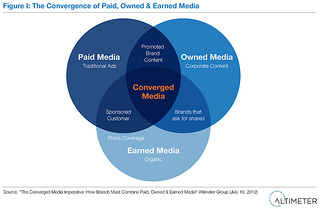
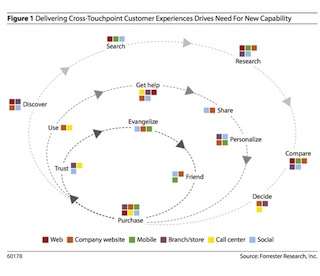
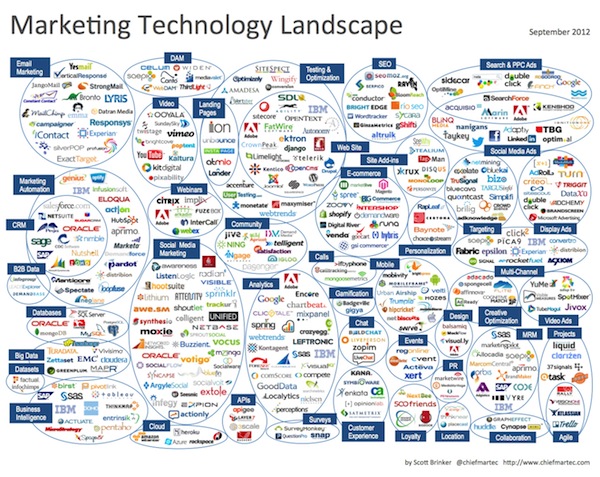
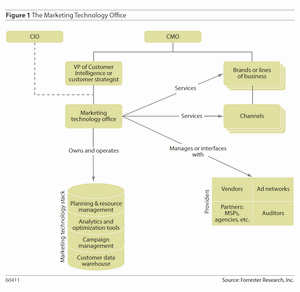
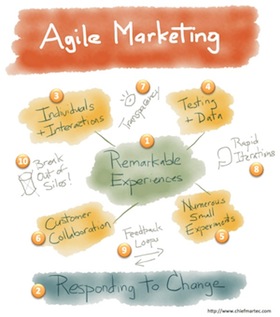
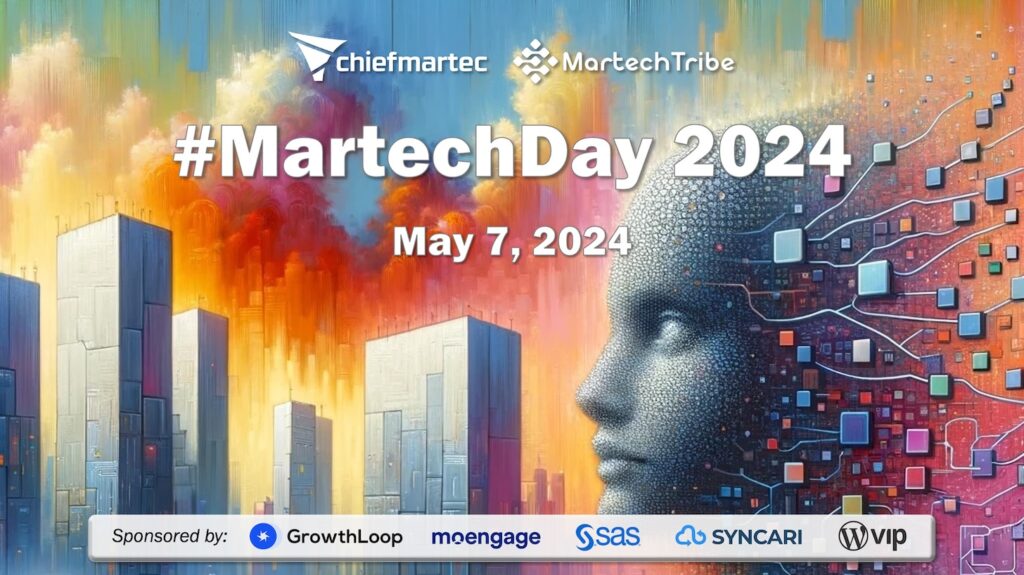
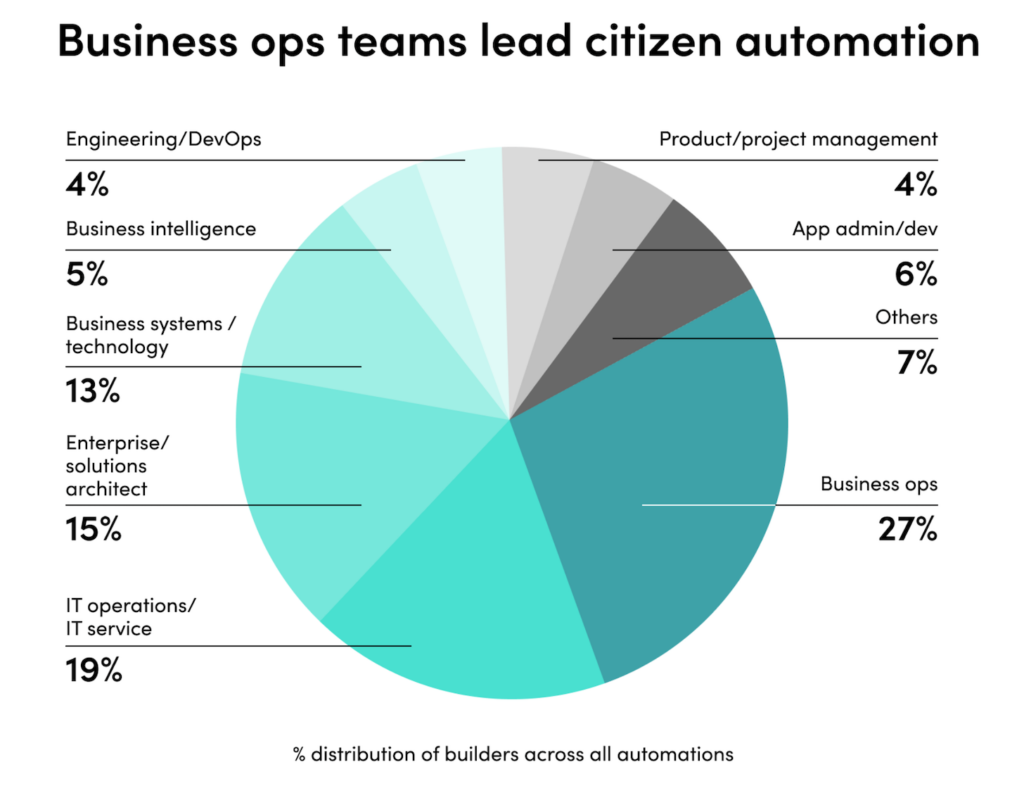

a lot of work put into this great presentation. Thanks!
Says everything that anyone involved in marketing today should be saying (and more importantly doing).
Amazing presentation. So good I’m tweeting it from our company’s account too 🙂 we endorse your expertise.
Great Post!
This post is the best post I’ve seen on describing the changing marketing landscape in all of 2012 … and I read A LOT of blogs. Awesome. Thanks for dedicating the time to writing this and for sharing it.
Thank you!
Great presentation Scott. Very in-depth analysis of the current state of marketing showing how, now more than ever, we need to apply new methodologies such as Agile and Lean to be able to quickly react to an ever-evolving market.
Technology is also becoming an integrated part of digital marketing and our roles, as marketers, has deeply evolved in the recent years.
And this is only the beginning!
Thanks again.
Pingback: Finding Simplicity on the Other Side of Complexity | Holistic Marketing Concepts for Business
really great presentation and very helpful
Scott,
This is an amazing talk / write up. And its still so relevant even after an year. Thanks for putting this together for us!!
Scott great post. Just wondering if you still feel these trends are relevant in almost 2016! Would love a response soon as I’m researching a topic – the key trends affecting the marketing strategy. thanks